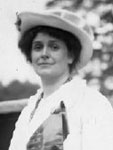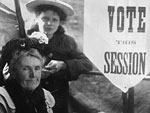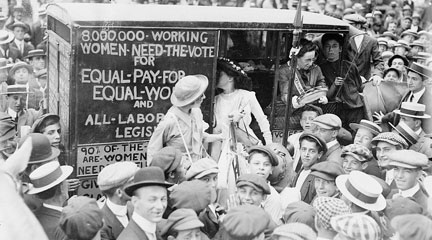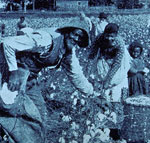Women's Suffrage Cartoon
Video 1:
- Cartoon. "Dirty Pool of Politics." California Women and the Vote Collection, The Bancroft Library, University of California.
- Advertisement. "Take Mirrors For Instance." 1917. Ivory Soap Advertising Collection, 1883–1998. National Museum of American History, Smithsonian Institution.
- Article. "Clean Chicago Law is Passed." Chicago Tribune, February 19, 1901.
- Article. "Pure Foods Defined." Washington Post, October 21, 1906.
- Advertisement. "Votes for Women." National Magazine, March, 1913.
- Advertisement. "Purity." 1921. Ivory Soap Advertising Collection, 1883–1998. National Museum of American History, Smithsonian Institution.
- Illustration. "Is Woman's Sphere the Home When Man Surrounded Her Children With Evil?" Life Magazine, October 16, 1913.
- Print. Pogány, Willy. "Men! Give Women Votes to Protect the Children." 1914. New York Public Library Digital Gallery, Image ID: 1536880.
- Illustration. "Lansing Sanitary Drinking Fountain." 1912.
Video 2:
- Photo. "Brady, Alice." New York Public Library Digital Gallery, Image ID: 111484.
- Photo. "Scene in the Revival of Pirates of Penzance at the Casino." Theatre Magazine, July 1912.
- Photo. Harris & Ewing. "Burns, Miss Lucy of C.U.W.S." 1913. Library of Congress Prints and Photographs Division, Reproduction No. LC-DIG-hec-03458.
- Photo. "Reception tea at the National Womens Party to Alice Brady." April 5, 1923. Library of Congress Prints and Photographs Division, Reproduction No.LC-USZ62-102300.
Video 3:
- Photo. "Hundreds of Children Must Walk Daily Though This Infernal Region." From Fighting the Traffic in Young Girls by Ernest A. Bell (G.S. Ball, 1910).
- Photo. "My God! If I Could Only Get Our Of Here!" From Fighting the Traffic in Young Girls by Ernest A. Bell (G.S. Ball, 1910).
- Postcard. Crowd outside Portola Theatre. 1915. Collection of San Francisco Bay Area Theater Images and Memorabilia, Museum of Performance and Design.
- Photo. Harris & Ewing. "National Anti-Suffrage Association." c.1911. Library of Congress, Prints and Photographs Division, Reproduction No. LC-USZ62-25338.
- Photo. "Mrs. Arthur M. Dodge." Everybody's Magazine, July 1915, 11.
- Newpaper. The Remonstrance, quarterly publication of Massachusetts Association Opposed to the Further Extension of Suffrage to Women. Library of Congress, Rare Book and Special Collections Division, Miller NAWSA Suffrage Scrapbooks, 1897-1911.
- Pamphlet. Northern California Association Opposed to Woman Suffrage. "Some Reasons Why We Oppose Votes for Women." 1912. California Women and the Vote Collection, The Bancroft Library, University of California.
- Article. Marshall, Edward. "Our Suffrage Movement is Flirtation on a Big Scale." New York Times, May 25, 1913.
How does a cartoon (c. 1910) supporting suffrage portray women? TJ Boisseau breaks down the popular views of women's roles and abilities that this cartoon uses to convince viewers to support women's right to vote. How does the cartoon make women's perceived talents as housekeepers and guardians of the private, domestic sphere important in the public world of politics?
One of the things that I would emphasize with students are the abundance of political cartoons that are produced in the first two decades of the 20th century. Mainly because this is a moment when the mass circulation of daily newspapers has reached its full potential and is reaching hundreds of thousands of customers in each city locale and also across cities.
This cartoon, which is called "The Dirty Pool of Politics," and what it shows is a fashionably dressed woman with an elaborate hat and very up-to-date and trendy clothes with a shovel, and she's shoveling dirt in front of her as she goes and the dirt is characterized as "White Slavery," Graft, Food Adulteration—and these are problems of the city, of the moment. And the point of the cartoon—which says, "Can we clean it? Give us a chance"—is to talk about how women are imagined as having a greater instinct for cleaning, a greater commitment to it, and investment of it, a set of skills and experiences that allows them to be, not only the cleaners of their own homes, but municipal housecleaners. This is a very prominent theme by the 1890s and by 1900, when suffrage becomes once again on the public consciousness and you see the merging of the two kind of rival suffrage associations—the NWSA [National Woman Suffrage Association] and the American Women's Suffrage Association—the national and the American. This is what they're going to, in a large part, base their rationale on.
So instead of what we had seen for most of the second half of the 19th century, which was an emphasis on the human right to political participation that should be shared equally by men and women, so a principle, you see a change in tactics. Not that many of the suffragists actually gave up thinking along those lines, but they certainly switched rhetoric to something they felt would be more practical, more pragmatic, and some historians have used the term expedient. The one closest to hand was the idea that women are responsible for the home and in an industrialized context the home is no longer a private domicile that a woman has control over the quality of. So if you want to be able to clean up your home, if you want—one of the things in this cartoon was food adulteration, you want to make sure that the meat that your serving your children is healthy and not rotten, that the fruit is clean and hasn't been soiled by being sitting out in an open market, if you want to make sure that the water coming into the home does not have disease in it, does not have airborne or waterborne diseases. All of those things [are] going to require the woman to actually step out of the private sphere and into the public sphere and have some political participation and some influence and control.
So this cartoon shows you right at the beginning of that movement the opportunity that women are seizing upon. To say we require the vote in order to be the traditional mothers and homemakers that we agree we primarily are. It's a very powerful and very effective and strategic argument and a cartoon like this says it in a very short punchy way.
One of the things I might demonstrate for students is to how to read the document visually. So not only how to look at the caption and think about the context and talk about the politics of the moment, but also to really look at the visual. And I emphasized at the beginning of my description that this woman is very fashionably dressed. And what that should raise for students are questions of class and also questions of how women needed to portray themselves in public in order not to violate not only the traditional idea that they are the domestic managers, but also that they need to look attractive.
So one of the other things that suffragists by the early 20th century figure out and manage to get a hold on to is that they're going to be much more publicly effective if they come across as appealing, attractive, fashionable, rather than militant in a specific way, meaning hostile to the role that women play as ornament. So you see the combining of these two things—that you can be a political person who seems to be stepping out of her sphere and not unattractive to men, and not uncaring about one's appearance. And also that this is an issue that upper-class women can grasp hold of and find an investment in, in addition to their philanthropy, in addition to their charity work, they can see political participation as something that aids them in that. Because it's not—it is their home that is at issue, but it's also poor women, immigrant women, women who have recently migrated to cities who live in tenement slums whose water is choleric, whose garbage is right outside their door—homes where they don't have any control over the quality. So, I think that cartoon says a lot and you can talk to the students for a long time about all the different aspects of this.
One of the things I would also point out and that the students are usually struck by are the demon-like figures of Food Adulteration, Graft, White Slavery, Bribery—that these are the evils that plague our society at the moment. These are the things that threaten the nation, they threaten industrial production, that these are key important issues. But if you look closely at what they are, they're also a lot about two things. Political corruption, so the idea also is that women might be more moral because they come from a sphere that is imagined as uncompromised by capitalism. So they can come in with not only fresh eyes and a fresh perspective, but they are also treading on a kind of conventional idea that has grown in the minds of many for the past century that women bring a moral sensibility. So they wouldn't stand for corruption and bribery.
White Slavery is kind of thrown in there, and that might be something that you might also talk to students about—it might take you a little bit off topic, but this is how I would keep it on topic. White slavery is the notion that women—white women—rather than black people, the whiteness there is very key, are being taken across state lines, are being forced into prostitution, being forced into sex slavery. And again this is imagined as a woman's issue, because women are thought to care about the lives of other women and about the moral turpitude or the moral character in general of society at large. So there's a lot you can do with a very concise image if you really take a look at it and mine it for all the different dimensions that it presents.
One of the reasons that I think that this is a key issue is that of course there's also an anti-suffrage movement. And it's not made up only of men who can't see past the idea that women will be their helpmates and be there for them when they get home from work—it's also made up of a good number of women—a significant portion, especially of upper-class women, who feel—who agree that women might have to step out of the private sphere into the public sphere but they want to do so much more carefully. They're much more circumspect about official roles in the public sphere, particularly the vote. And here's the logic to that—and there is a logic to that, it's not simply a misogynist or diluted or consciousness problem, it’s a logic of the argument of being a social housekeeper and the moral force in society. If your moral character comes from being protected from the public sphere, it comes from being solely responsible for the care of children and loved ones in the family unit, then the fear is that if you step too far outside of that, you yourself will lose those qualities. So what anti-suffrage women argued is that women should take responsibility for households other than their own, for the community and maybe the city at large and that there were roles for them to do so. There were professional occupations such as social worker, there were reasons to do that, but that the ballot went too far. The ballot put them in the same position as men and might actually erode the special qualities that they brought to the question of something like public health. So the public health campaign is central to the Progressive era, it becomes central to the tug of war between women over whether or not to support suffrage or not.



